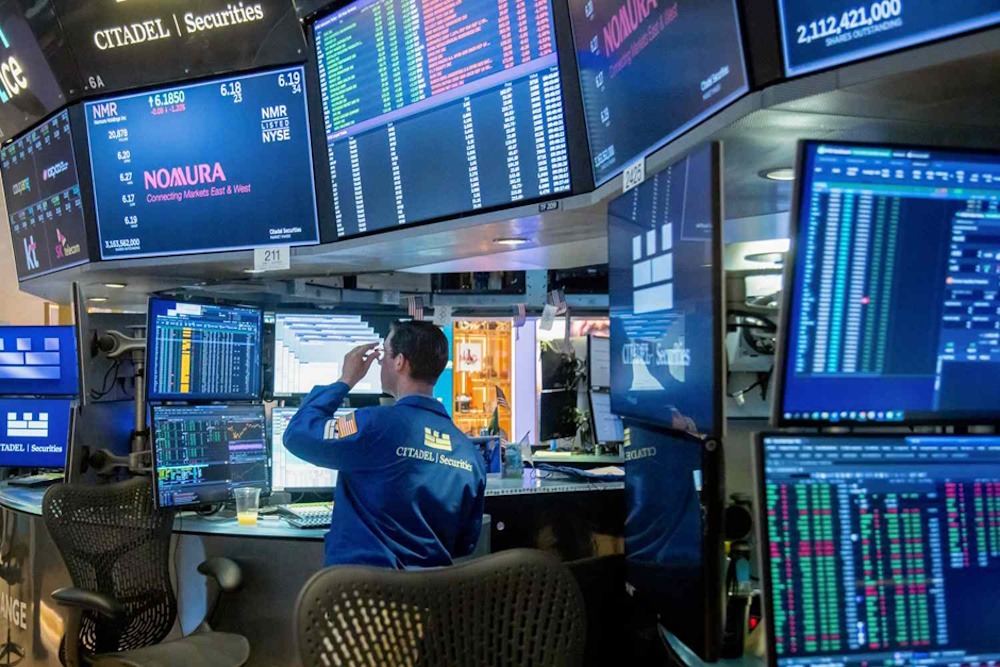
Dow futures are increasing in anticipation of the release of crucial inflation data, which could influence a significant forthcoming decision regarding Federal Reserve monetary policy. Meanwhile, the European Central Bank is expected to maintain interest rates at their current levels when it reveals its policy announcement on Thursday. On the earnings front, Adobe, the maker of Photoshop, will attract attention when it reports.
Dow futures indicated an upward trend on Thursday as investors prepared for the forthcoming release of crucial consumer price data, which may influence the direction of Federal Reserve interest rate policy. As of 03:10, the Dow futures contract experienced an increase of 35 points, representing a rise of 0.1%. Similarly, S&P 500 futures advanced by 8 points, also reflecting a 0.1% gain, while Nasdaq 100 futures saw an uptick of 39 points, equating to a 0.2% increase. The primary indices concluded the day with varied results on Wednesday, as investors assessed a stellar earnings report from the artificial intelligence-driven cloud software company Oracle and an unforeseen decline in producer prices for August, which strengthened expectations for a forthcoming Federal Reserve rate reduction. Both the benchmark S&P 500 and tech-heavy Nasdaq Composite indices reached unprecedented heights, significantly driven by a notable increase in Oracle’s shares. The stock surged by 36% – its most significant one-day increase since 1992, bringing its market capitalization close to the $1 trillion threshold. The blue-chip Dow Jones Industrial Average, meanwhile, declined by 0.48%.
Attention is shifting towards the consumer price index for August, an essential indicator of inflationary dynamics. The data from the Labor Department’s Bureau of Labor Statistics is expected to indicate that prices increased at an annualized rate of 2.9% in August, reflecting a modest acceleration from 2.7% in July. At that level, the Fed would likely encounter concurrent challenges to both aspects of its dual mandate – maximizing employment and ensuring price stability, which is defined as a long-run inflation rate of 2%. This would leave policymakers with the challenging task of simultaneously addressing a cooling labor market and persistent prices, an economic situation that could threaten to transition into a period of “stagflation” characterized by high inflation, sluggish growth, and elevated unemployment. However, a separate report on Wednesday indicated an unexpected decrease in U.S. factory-gate prices in August. Analysts noted that prices in tariff-exposed categories, in particular, remained relatively subdued. Thus far, officials from the Federal Reserve, including Chair Jerome Powell, have signaled a tendency to prioritize the softening of the labor market over concerns regarding inflation. A rate cut could theoretically stimulate increased investment and hiring, although it carries the risk of exacerbating inflationary pressures.
Before the Federal Reserve’s decision during its meeting on September 16-17, the European Central Bank is set to announce its own interest rate decision on Thursday. The ECB is expected to maintain the current level of borrowing costs. Nevertheless, analysts observed that the discourse between proponents of maintaining rates and advocates for a reduction “will likely be more intense than markets have anticipated.” Perceived hawkish commentary from ECB President Christine Lagarde in July has influenced expectations for forthcoming rate adjustments, as the central bank observes inflationary pressures that are slightly higher than previously anticipated and economic growth that is outpacing expectations since its last meeting. These developments, coupled with persistent uncertainty regarding U.S. tariffs, have intensified speculation that the ECB will offer minimal clarity concerning its policy direction – and will likely maintain its key deposit rate at 2% for a second consecutive meeting.
Adobe, a provider of software tools, is set to headline the earnings calendar with its quarterly returns announcement scheduled for after the closing bell. Sentiment surrounding the company responsible for the Photoshop image editor and Acrobat Pro file manager is unfavorable, as numerous investors have pointed out that Adobe encounters “significant cyclical and secular headwinds,” according to analysts. The company is projected to report fiscal third-quarter earnings per share of $5.18 alongside sales of $5.91 billion, according to Bloomberg consensus estimates. In June, San Jose-based Adobe raised its annual financial guidance; however, observers expressed concerns regarding the timeline for the business to realize benefits from its AI adoption.
Oil prices declined due to weak demand in the United States, following significant increases earlier this week driven by heightened geopolitical tensions in Russia and the Middle East. At 03:36 ET, Brent futures decreased by 0.1% to $67.40 per barrel, while U.S. West Texas Intermediate crude futures declined by 0.2% to $63.56 per barrel. U.S. crude inventories increased by 3.9 million barrels in the week ending September 5, according to the Energy Information Administration’s report released late Wednesday, contrasting with forecasts that anticipated a draw of 1 million barrels. Gasoline stocks increased by 1.5 million barrels, contrary to expectations of a decrease of 200,000 barrels. Evidence of a decelerating U.S. economy will heighten apprehensions that demand from the world’s largest energy consumer is poised to diminish as the year unfolds. In other markets, gold prices experienced a slight decline as investors exercised caution ahead of the U.S. consumer price report. Nevertheless, the yellow metal remained near record highs, bolstered by strong expectations that the Federal Reserve will implement interest rate cuts in the upcoming week. Bullion exhibits a notable sensitivity to borrowing costs, given that lower rates diminish the opportunity cost associated with holding this non-yielding asset.
